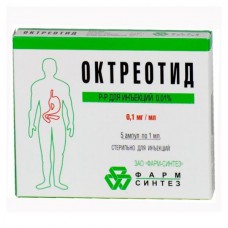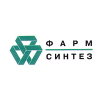Expiration date: 12/2026
The composition and form of issue:
Injection of 0.005 and 0.01%
octreotide (as free peptide), 50 or 100 mg
sodium chloride 9 g, water for injection up to 1 l
in 1 ml ampoules in a box 5, or 10 PCs.
Description pharmaceutical form:
Clear, colorless, odorless liquid.
Feature:
Synthetic octapeptide derivative of the natural hormone somatostatin.
Pharmacokinetics:
After p/to the introduction rapidly and completely absorbed. Cmax is reached after 30 min. the plasma protein Binding is 65%, total body clearance is 160 ml/min, T1/2 — 100 min. Approximately 32% is excreted unchanged by the kidneys. After intravenous injection the elimination is carried out in 2 phases with T1/2 of 10 and 90 min in elderly patients, decreases clearance and T1/2 increases. In severe renal insufficiency, clearance is decreased 2 times.
Description pharmacological action:
Has similar to natural somatostatin pharmacological effects, but a much greater duration of action. Inhibits pathologically increased secretion of growth hormone and of peptides and serotonin produced in gastroenteropancreatic endocrine system.
Patients undergoing surgery on the pancreas, use of octreotide during surgery and after it reduces the incidence of typical postoperative complications (pancreatic fistula, abscess, sepsis, acute postoperative pancreatitis, etc.).
Indications:
- prevention and treatment of complications after operations on the abdominal organs
- stopping bleeding and prevention of re-bleeding from varicose veins of the esophagus in patients with liver cirrhosis
- treatment of acute pancreatitis
- stop ulcerative bleeding.
Contraindications:
Hypersensitivity (including to the drug component).
With caution:
- cholelithiasis
- diabetes
- pregnancy
- lactation.
Application of pregnancy and breast-feeding:
Adequate and controlled studies in humans have not been conducted. Use during pregnancy and lactation is possible only on the absolute indications, when the expected benefit to the mother outweighs risk to the fetus. Category effects on the fetus — B.
Side effects:
On the part of the digestive tract: possible anorexia, nausea, vomiting, spastic abdominal pain, bloating, abdominal wall tension, diarrhea, steatorrhea. Although the allocation of fat with faeces may increase, there is no indication that long-term treatment with octreotide may result in development of malabsorption (malabsorption). In rare cases, can be observed phenomenon resembling acute intestinal obstruction.
There are some known cases of acute hepatitis without cholestasis, and hyperbilirubinemia combined with an increase in the activity of alkaline phosphatase, gamma-glutamyltransferase and, to a lesser extent, other transaminases.
Prolonged use of octreotide may lead to the formation of stones in the gallbladder.
In foreign literature it was reported about rare cases of acute pancreatitis, which developed during the first hours or days of use and disappeared after discontinuation of octreotide.
From cardiovascular system: in single cases — arrhythmia, bradycardia.
From the metabolic: possible violation of tolerance to glucose after a meal (due to suppression of the secretion of insulin), hypoglycaemia in rare cases, prolonged treatment may develop persistent hyperglycemia.
Local reactions: pain at the injection site, itching and/or burning, redness, swelling (usually disappear within 15 min).
Other: allergic reactions, alopecia.
Drug interactions:
The required adjustment of the doses at the same time used diuretics, beta-adrenoblokatorov, antagonists of calcium, insulin, oral hypoglycemic agents.
While the use of octreotide and bromocriptine increases the bioavailability of the latter.
Drugs metabolized by enzymes of cytochrome P450 and have narrow therapeutic range of doses should be administered with caution.
Method of application and dose:
P/K, V/V.
Acute pancreatitis — n/a 100 µg 3 times a day for 5 days. You can assign up to 1200 mg/day, using I/V route of administration.
Prevention of complications after operations on the pancreas — SC 100 mcg for 1 h before laparotomy, and then after surgery — 100 mg 3 times a day for 7 consecutive days.
To stop bleeding from varicose veins of esophagus — I/25-50 µg/h in a continuous infusion for 5 days. In elderly patients there is no need to reduce the dose of octreotide.
To stop peptic ulcer bleeding in a 25 µg/h in the form of infusions over 5 days.
Overdose:
Symptoms: intermittent slowing the heart rate, feeling tide blood to a person, spastic abdominal pain, diarrhea, nausea, a feeling of emptiness in the stomach.
Treatment: symptomatic.
Special instructions:
Diabetic patients receiving insulin, octreotide may reduce insulin requirements.
If gallstones are identified before treatment, the question of the use of octreotide is solved individually, depending on the ratio of the potential therapeutic effect and possible risk factors associated with the presence of stones in the gallbladder.
Side effects from the gastrointestinal tract can be reduced if the injection of octreotide to do in the intervals between meals or at bedtime.
To reduce the effects of discomfort at the injection site is recommended to bring the solution of the drug before administration to room temperature and introduce the possibilities to a lesser extent. You should avoid multiple injections in the same place at short intervals of time.



